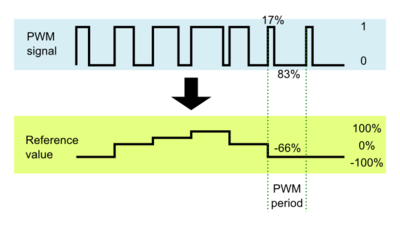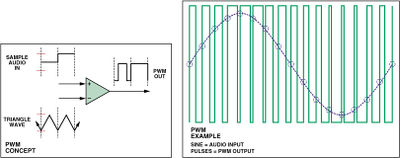Difference between revisions of "PWM"
| [unchecked revision] | [checked revision] |
(Created page with "PWM a.k.a. Pulse width modulation is a voltage waveform usually seen in power electronics such as motor drives and power supplies. The main idea in PWM is to switch input vol...") |
|||
| (27 intermediate revisions by 4 users not shown) | |||
| Line 1: | Line 1: | ||
| − | PWM a.k.a. | + | [[File:pwm_wiki.png|thumb|PWM signal as setpoint|400px]][[File:pwm_vs_analog.jpg|thumb|Another illustration of PWM nature. On the left side there is a simple circuit for converting analog voltage into PWM signal. Image credit analog.com.|400px]] |
| + | PWM a.k.a. pulse-width modulation is a voltage waveform usually seen in power electronics such as motor drives and power supplies. It has been also used as [[setpoint signal]]. | ||
| − | The main idea in PWM is to switch | + | The main idea in PWM is to switch voltage either fully ''on'' or ''off'' so rapidly that receiving device "feels" only the average voltage caused by pulsed voltage. |
| − | == | + | ==Duty cycle== |
| − | ===Pros=== | + | Duty cycle describes the ratio of pulse on/off timing. Duty cycle is varied to produce different effective voltages. |
| + | |||
| + | I.e. if duty cycle is 10%, then the PWM signal is "on" for 10% of time and "off" for 90% of time. I.e. if "on" equals voltage of 48VDC and "off" 0VDC, then 10% duty cycle equals effective voltage of 4.8VDC (48*10% + 0*90% = 4.8). | ||
| + | |||
| + | ==Frequency== | ||
| + | Frequency describes how often on/off states appear in PWM signal. I.e. if PWM frequency is 20 kHz then there will be 20000 "on" and "off" periods per second. Frequency is typically kept constant over time. | ||
| + | |||
| + | In motor & power control it is typical to use at least 15 kHz PWM frequency to avoid audible high pitched noise that coils produce when driven by PWM. | ||
| + | |||
| + | ==Usage in GD products== | ||
| + | ===As motor output=== | ||
| + | All GD motor drives produce PWM signal to motor. I.e. if drive supply voltage is 48VDC, then motor output pins will be driven either to 0V or 48V at switching rate of 15-20kHz. VSD drives use MOSFET or IGBT based [http://en.wikipedia.org/wiki/H-Bridge half-bridge] circuits to produce the power PWM output. | ||
| + | |||
| + | Inductance of motor coils will average the PWM pulses to equivalent DC. If motor inductance is very low, additional inductor is needed between drive and motor phases. | ||
| + | ====Pros and cons in drive applications==== | ||
| + | ;Pros | ||
* Very high efficiency due to low losses in electronics | * Very high efficiency due to low losses in electronics | ||
| + | * Usually very little heat sinking needed | ||
| + | * Easy to produce in digital circuits | ||
* Robust | * Robust | ||
| − | + | ;Cons | |
| − | * Increased [[Electromagnetic interference | + | * Increased [[Electromagnetic interference|EMI noise]] compared to linear voltage |
| + | * [[Dead-time distortion]] | ||
| + | ===As setpoint signal=== | ||
| + | In some drive models, PWM signal can be used also as [[setpoint signal]] to replace analog signal (the +/- 10V control). In this case PWM voltage is typically 3-5V and the duty cycle of signal determines the amplitude. | ||
| + | |||
| + | Compared to analog input in VSD products 0% PWM duty cycle equals -10V, 50% equals 0V and 100% equals +10V. Benefits of using PWM instead of analog setpoint: | ||
| + | * [[Electromagnetic interference|EMI noise]] tolerant | ||
| + | * Easy to galvanically isolate | ||
| + | * Easy to generate from digital circuits | ||
| + | |||
==Links== | ==Links== | ||
[http://en.wikipedia.org/wiki/Pulse-width_modulation Wikipedia PWM article] | [http://en.wikipedia.org/wiki/Pulse-width_modulation Wikipedia PWM article] | ||
| + | |||
| + | [[Category:Glossary]] | ||
| + | [[Category:Signals]] | ||
Latest revision as of 14:20, 14 October 2017
PWM a.k.a. pulse-width modulation is a voltage waveform usually seen in power electronics such as motor drives and power supplies. It has been also used as setpoint signal.
The main idea in PWM is to switch voltage either fully on or off so rapidly that receiving device "feels" only the average voltage caused by pulsed voltage.
Contents
Duty cycle[edit | edit source]
Duty cycle describes the ratio of pulse on/off timing. Duty cycle is varied to produce different effective voltages.
I.e. if duty cycle is 10%, then the PWM signal is "on" for 10% of time and "off" for 90% of time. I.e. if "on" equals voltage of 48VDC and "off" 0VDC, then 10% duty cycle equals effective voltage of 4.8VDC (48*10% + 0*90% = 4.8).
Frequency[edit | edit source]
Frequency describes how often on/off states appear in PWM signal. I.e. if PWM frequency is 20 kHz then there will be 20000 "on" and "off" periods per second. Frequency is typically kept constant over time.
In motor & power control it is typical to use at least 15 kHz PWM frequency to avoid audible high pitched noise that coils produce when driven by PWM.
Usage in GD products[edit | edit source]
As motor output[edit | edit source]
All GD motor drives produce PWM signal to motor. I.e. if drive supply voltage is 48VDC, then motor output pins will be driven either to 0V or 48V at switching rate of 15-20kHz. VSD drives use MOSFET or IGBT based half-bridge circuits to produce the power PWM output.
Inductance of motor coils will average the PWM pulses to equivalent DC. If motor inductance is very low, additional inductor is needed between drive and motor phases.
Pros and cons in drive applications[edit | edit source]
- Pros
- Very high efficiency due to low losses in electronics
- Usually very little heat sinking needed
- Easy to produce in digital circuits
- Robust
- Cons
- Increased EMI noise compared to linear voltage
- Dead-time distortion
As setpoint signal[edit | edit source]
In some drive models, PWM signal can be used also as setpoint signal to replace analog signal (the +/- 10V control). In this case PWM voltage is typically 3-5V and the duty cycle of signal determines the amplitude.
Compared to analog input in VSD products 0% PWM duty cycle equals -10V, 50% equals 0V and 100% equals +10V. Benefits of using PWM instead of analog setpoint:
- EMI noise tolerant
- Easy to galvanically isolate
- Easy to generate from digital circuits

